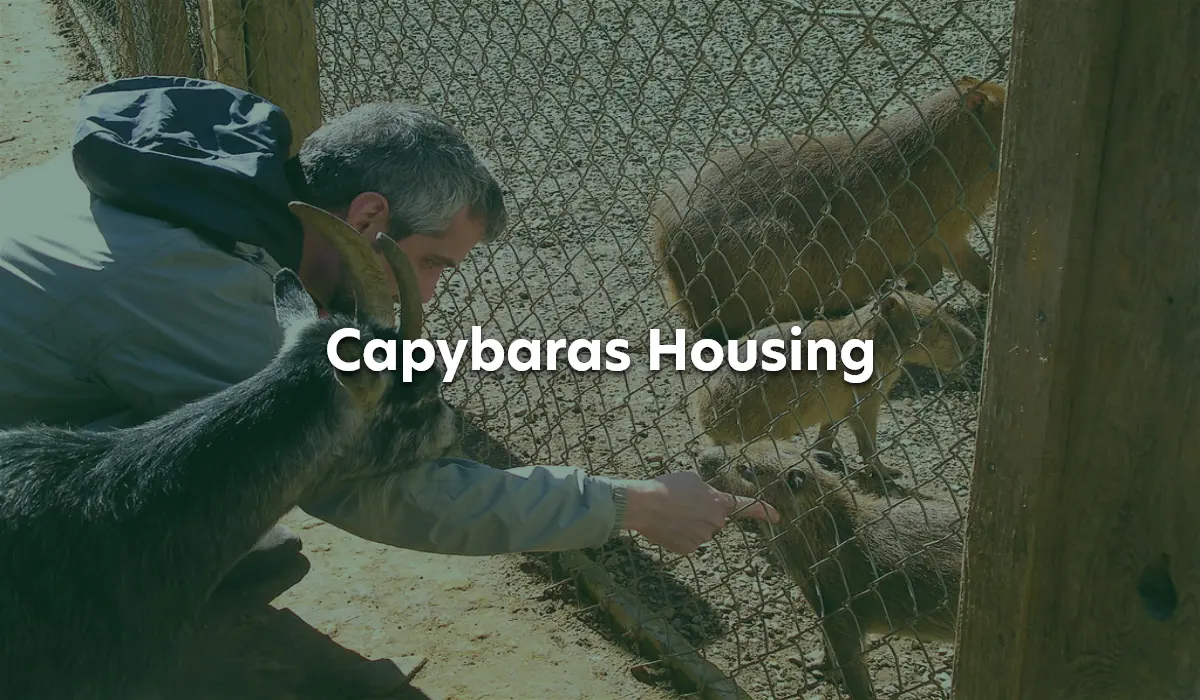Capybaras are charming creatures that have captured the hearts of many with their docile and friendly nature. Originating from South America, these fascinating rodents have seen a surge of popularity as pets in recent years.
When it comes to capybaras best housing options, providing an ideal living environment is crucial for their health and happiness. To ensure your capybara thrives in their new home, we’ve outlined several essential factors for you to consider.
Capybaras Best Housing Options: Indoor vs. Outdoor
Capybaras are highly adaptable animals and can adjust to either indoor or outdoor living spaces.
However, the key to a comfortable capybara habitat is providing ample space, enrichment, and access to water.
Below, we’ll discuss some critical factors to consider when designing your indoor or outdoor enclosure.
Creating a Cozy Indoor Habitat for Your Capybara
Indoor housing for capybaras can be tricky, as their large size and penchant for exploring demand plenty of space.
Here are some factors to consider when setting up an indoor capybara habitat:
- Spacious Living Quarters: Designate a large room, such as a basement or converted garage, as the primary living space for your capybara. A minimum floor space of 12×12 feet (3.6 x 3.6 meters) is necessary for your pet to roam comfortably.
- Appropriate Flooring: Choose hard, durable flooring materials, such as tile, concrete, or linoleum, to help keep your capybara’s nails trimmed. Avoid using carpet, as capybaras have a habit of chewing and digging into them.
- Adequate Ventilation: Proper air circulation is critical in preventing respiratory issues and maintaining a clean, odor-free environment for your capybara.
- Enrichment Opportunities: Incorporating toys, hideouts, and climbing structures will engage your pet’s curiosity and help prevent boredom.
Designing an Idyllic Outdoor Enclosure for Your Capybara
An outdoor living space is typically a more natural and ideal option for capybaras to thrive.
When building an outdoor enclosure for your pet, consider the following factors:
- Sizeable Enclosure: A minimum of 1000 square feet (93 square meters) should be provided for one or two capybaras, with additional space necessary when housing more than two animals.
- Secure Fencing: Install a strong, durable fence at least 5 feet (1.5 meters) in height to accommodate the capybara’s agility and climbing abilities. A dig-proof barrier along the fence’s base will also help prevent escape attempts.
- Weatherproof Shelter: Equip your enclosure with a large, weather-resistant structure like a doghouse for your capybara to take refuge during inclement weather or rest.
- Natural Enrichment: Include logs, rocks, plants, and additional toys to mimic a natural habitat, thus encouraging exploration and play.
Prioritizing Access to Water in Your Capybara’s Living Space
Can capybaras swim? Yes. Since capybaras are semiaquatic creatures, providing constant access to water is essential for their well-being.
A swimming area, which helps release excess body heat and promotes relaxation, should be included in their living area.
Consider the following requirements when creating a swimming space for your capybara:
- Swimming Area Specifications: A small pond, pool, or sizeable stock tank with minimum dimensions of 6×4 feet (1.8×1.2 meters) and a depth of 2 feet (0.6 meters) will suffice.
- Water Cleanliness: Avoid using chemicals in the water and change it regularly to maintain cleanliness. A filtration system is also advised for optimal water quality.
- Accessibility: Install a ramp or create a gentle slope for your capybara to easily enter and exit the water.
Encouraging Socialization and Companionship for Your Capybara
As highly social animals, capybaras require companionship to thrive. Consider adopting another capybara or introducing other animal species like rabbits, goats, or ducks as potential companions.
Familiarize yourself with each species’ compatibility to ensure harmonious coexistence and mutual emotional well-being.
Maintaining a Well-Balanced and Nutritious Diet
Providing a balanced diet is crucial to ensure your capybara’s overall health and happiness.
Keep these pointers in mind when formulating their meal plan:
- Feed your capybara a diet primarily comprised of hay, like Timothy hay, to support digestion and teeth health.
- Offer a moderate portion of fresh vegetables, fruits, and leafy greens daily, while avoiding foods high in sugar and fat.
- Ensure access to freshwater through a bowl or dispenser at all times.
By implementing these suggestions and providing ample space, access to water, a diverse diet, and suitable companions, your capybara will flourish in your care.
Remember to consult a veterinarian experienced in capybara care for additional guidance and always stay informed about their unique needs to ensure their well-being.
